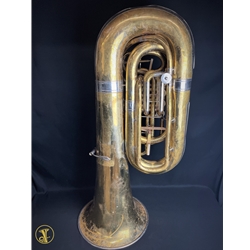

Silvestre Revueltas: Sensemayá, Noche de los mayas, Homenaje a Federico García LorcaĬoncertos have been written for the tuba by many notable composers, including Ralph Vaughan Williams, Edward Gregson, John Williams, Alexander Arutiunian, Eric Ewazen, James Barnes, Martin Ellerby, Philip Sparke, Kalevi Aho, Arild Plau, James Woodward, Victor Davies, Josef Tal and Bruce Broughton.Richard Wagner: Die Meistersinger von Nürnberg, Lohengrin, Ride of the Valkyries.Richard Strauss: Also sprach Zarathustra, Eine Alpensinfonie.Ravel): Pictures at an Exhibition - Bydlo, Night On Bald Mountain Well known and influential parts for the tuba include: It serves as the bass of the brass section and of brass quintets and choirs, as well as reinforcement for the bass voices of the strings and woodwinds, and as a solo instrument. It is the principal bass instrument in symphonic and military bands, and those ensembles generally have more. RolesĪn orchestra usually has a single tuba, though an additional tuba may be asked for. Sax's instruments gained dominance in France, and later in Britain and America, as a result of the popularity and movements of instrument makers such as Gustave Auguste Besson (who moved from France to Britain) and Henry Distin (who found his way eventually to America). The instruments developed by Sax were generally pitched in E-flat and B-flat, while the Wieprecht "basstuba" and the subsequent Cerveny contrabass tuba were pitched in F and C (see below on pitch systems).

#BBB HIRSBRUNNER TUBA SERIES#
By using valves to adjust the length of the bugle the tuba produced a smoother tone that eventually led to its popularity.Īdolphe Sax, like Wieprecht, was interested in marketing systems of instruments from soprano to bass, and developed a series of brass instruments known as saxhorns. While this changed the pitch, it also had a pronounced effect on the timbre. Tone holes changed the pitch by providing an intentional leak in the bugle of the instrument. Another forerunner to the tuba was the serpent, a bass brass instrument that was shaped in a wavy form to make the tone holes accessible to the player. The ophicleide used a cup-shaped brass instrument mouthpiece but employed keys and tone holes similar to those of a modern saxophone. Harmonics starting three octaves above the fundamental pitch are about a whole step apart, making a useful variety of notes possible. Prior to the invention of valves, brass instruments were limited to notes in the harmonic series, and were thus generally played very high with respect to their fundamental pitch. The addition of valves made it possible to play low in the harmonic series of the instrument and still have a complete selection of notes. The original Wieprecht and Moritz instrument used five valves of the Berlinerpumpen type that were the forerunners of the modern rotary valve. 19 was granted to Wilhelm Friedrich Wieprecht and Carl Moritz on Septemfor a "basstuba" in F1.


 0 kommentar(er)
0 kommentar(er)
